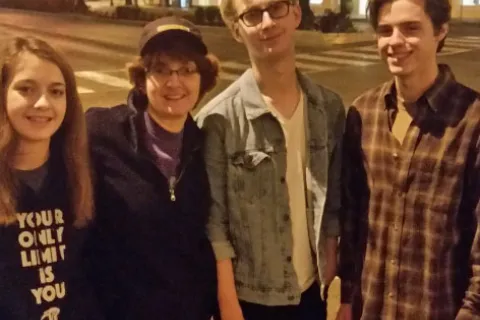Transition from school-based services to HCBS Waiver adult services
An autistic adult's ten-year journey to achieving her transition goals
By Chloe RothschildI started transition planning at age 14, per the legal requirement in Ohio. As part of it, I participated in an early childhood education class, which involved learning to write lesson plans and volunteering in general and special education classrooms with young children. This was on top of my IEP which included adapted physical education, a teacher of students for the visually impaired, large print books, tests taken in a separate area, preferential seating, copies of notes, and sensory breaks. Additionally at age 16, I qualified for services through my local County Boards of Developmental Disabilities (CBDD) office based on life skills. I was assigned a services and support specialist who attended my IEP meetings to help with transition planning.
By the middle of my senior year, my family and I had decided that I would continue to receive school-age services until age 22. This fit with my transition plan which included what my school district called a social graduation. I walked in the graduation ceremony with my class of 2011, but the district held my diploma so that I could continue with an IEP.
After high school I enrolled in a district transition program that was vocational focused. It included time in a classroom learning office tasks and participating in leisure activities with support, and time volunteering at a local community center which ran a food bank, preschool, and fitness center with a kids’ area. I initially volunteered in the preschool but I just didn’t seem to like it. My teacher was committed to figuring out how to help. She accepted my words, which was very important. We tried focusing on other areas of the program but what became clear was that I needed a program that also focused on life skills.
My school district tried to accommodate my needs but it lacked resources. So my family and I began to look at other options. After about six months on a wait list, in April 2012, I switched to an autism charter school which I attended for the next 2.5 years. I worked on life skills, social skills, and employment skills. I got to volunteer at the local Autism Society doing office tasks. One of my classroom placements was in a “living classroom” that was a house next to the school where I could learn cooking, chores, and other skills in a real-life setting.
In September 2014, as my 22nd birthday approached, I became nervous about my pending transition from school to the world. While I had not qualified for any funding through CBDD when I was a teenager, I had assumed that I would automatically be eligible for an individual service plan and funding as an adult. But my family, school and I found out less than a month before that this was not the case. We were never made aware that this was a possibility, so we never even knew we should ask about it in advance.
So I worked with the transition coordinator at my school to make a last-minute plan to have some kind of structure while my family and I advocated for funding and services. Still, on my last day of school, reality hit that my school van was not coming the next morning. I was not going to school like I had since I was four-and-a-half years old. This was hard and made me feel upset. I don’t think this change is something you can ever be prepared enough for. This is why many people refer to aging out of school-age services as “falling off the cliff.”
I started part-time volunteer work at a local autism organization with a college student who functioned as a job coach. My family paid for their services privately. I also had a remote, very-part-time job typing in calendar events for a local business, which I had started while at the autism charter school.
Two months later, in November 2014, my family and I were still advocating for my waiver so I could access supports and services. After I had a meltdown during a meeting with someone from CBDD, they agreed that I needed funding. First though, my case had to go in front of the local CBDD for a review. I felt like this took forever, and it was emotionally difficult feeling like I had to prove my needs and my case to others.
Finally, two to three months later, my case was assigned to a service and support worker with CBDD. Unfortunately, she did not seem to know how to best meet my needs. In an email, she said that she was used to serving people with more intense disabilities and putting them in restrictive environments. This made me feel frustrated. I knew that this should not be happening, and this was definitely not something that should have been said to me.
Every single time I spoke with this person, I felt like I had to prove my needs to her. One time, when she asked my parents what their biggest fear was, and they said being hit by a car, she laughed and said, “I mean something that is more likely to happen.” Since I have a visual impairment, this was likely. Every time I met with this person, words were hard. I just wanted her to leave. I would type “Meeting over, please leave,” and other phrases on my iPad to someone who supported me.
In January of 2015, I was also given an individual budget through CBDD. I used my budget for home care services, which help with things such as working on grocery shopping, cooking, cleaning and other life skills. I also had one-on-one sessions with a behavior therapist who helped work on different coping skills. (Hear more about Chloe’s experience with ABA in her episode of Autism Speaks’ Adulting on the Spectrum podcast.) While I could have relied on the local board to find an agency, I was determined to find providers who could best meet my needs as an individual.
While I was happy with the providers I found, the limited budget meant that I couldn’t get enough hours with them. Because I learn best with a lot of repetition, there just wasn’t enough time with my providers to work on the daily living skills I would need to meet my goal of living independently one day. Also, I wanted more services like employment support and transportation that my current provider was not certified to offer.
So around this time, my parents and I decided to start the process of applying for a Medicaid waiver, including preparing my finances. Ohio has three different Medicaid waivers for those with intellectual and developmental disabilities: Level One Waiver, SELF Waiver, and Individual Options (IO) Waiver. The amount of funding goes up with each one. (It is important to note that the Department of Developmental Disabilities at the state level has announced that they formed a work group to focus on redesigning these waivers in the future.) Waivers can pay for things such as adult day programs; assistive technology or equipment; respite services for caregivers; direct service providers to offer support with cooking, cleaning, shopping, leisure, community outings and more; and non-medical transportation services.
The state uses an assessment to determine if you have an “immediate need” for services within 30 days or a “current need” for services within the next 12 months, which puts you on a waitlist. It can also find you ineligible for a waiver because your needs can be met using natural supports like family and friends, CBDD services, or other services. You can appeal this decision based on the assessment if you do not agree with it. You can also ask that the assessment be repeated whenever there is a change in needs.
After my assessment, I initially received the Level One Waiver. This gave me more hours with the same provider that was being funded with my CBDD budget. I was glad to receive a waiver, but I knew that in order to achieve my goal of living by myself with supports, I would need more services than what the Level One Waiver offered. For example, I wanted to be able to stay at my house overnight without my parents, but I didn’t have the direct support hours to do it. I also needed more time each week with my direct care providers to keep building my independent living skills.
So while I continued to receive my Level One Waiver, I asked for another assessment in hopes of getting my name on the wait list for the SELF Waiver. It proved to be a much bigger challenge than I expected. After the repeat assessment, I was told I would have to continue with the Level One Waiver. My family and I ended up appealing the decision with a lawyer who specializes in helping individuals with disabilities navigate the system. I attended multiple appeals and hearings, and I underwent five more assessments in a year and a half.
Finally, in 2020, the appeals court judge requested a new assessment because my needs had increased due to additional struggles I experienced during COVID. I collected so many letters from providers supporting my case and sent them to the hearing officer, the judge, and the assessor. At the end of October, I got notification that our hard work had paid off: I was being put on the wait list for the SELF Waiver. Two months later in December, I received it.
With the SELF Waiver I had the opportunity to practice working on independent living skills more frequently so that I could move out on my own. I practiced staying at my mom’s house with supports while she was on vacation, eventually working up to spending the night by myself. Knowing that I had the funding I needed to live independently one day also gave me peace of mind. There was less worry for me. More staffing hours had given me a greater level of independence from my parents.
In January of 2023, I achieved my ultimate goal and moved into my own place – a condo with a roommate near my family. This would not have been possible without the SELF Waiver. Because I had enough staffing hours, I was able to make the transition slowly. Now I have in-home supports at least five days a week. I get direct support provider hours for help with things like cooking, cleaning, grocery shopping, community outings and social events. I get transportation services to and from my job at a school for students with autism and to get around the community. I have also gotten funding for sensory items such as my crash pad and for my iPad as a communication device. I also get in-home ABA therapy hours through my health insurance. This is because my insurance is willing to cover it, and Medicaid waivers are considered the payer of last resort.
My needs will be reviewed each year during my individual service plan meeting. If my needs change, I can request another assessment to consider an IO Waiver. Theoretically, I could also change back to the Level One Waver, but because of recent changes in the system, the Level One Waiver and SELF Waiver now have the same funding limit.
In total, the process to get to where I am now has taken almost ten years since I left school-age services. Even now, I still have to advocate for services. I send emails to my service and support specialist asking to look into things like new equipment, issues with transportation vouchers, and discussing issues or incidents that come up.
Even though my family and I always understood that I may need lifelong support, we had no idea what it would actually take to access those services. I wish I knew that navigating the adult system took so much time, energy, and effort. I wish I knew that it was never something that could be done quickly or alone. I want to encourage others to advocate for what they need, even if it seems to be like pulling teeth and feels like it takes forever. Reach out to others who have already fought the battle and do not be afraid to reach out to the state level, like the Ohio Department of Developmental Disabilities, for guidance.
About the author
Chloe, 30, was diagnosed with developmental disabilities and a visual impairment in preschool. She attended public school with an IEP from age 4 until 19, when she moved to a public autism charter school until age 22. She now lives with a roommate, receiving supports through a Medicaid waiver and therapy through private health insurance. She works as a paraprofessional specializing in communication devices at a school for students with autism. She also serves on the board of directors for The Arc of the United States and the advisory board for the Ohio Center for Autism and Low Incidence (OCALI). She is a co-author of My Interoception Workbook: A Guide for Teens, Adolescents, and Adults.








